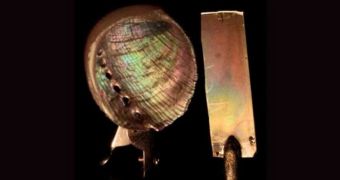University of Cambridge investigators say they can now produce a synthetic version of the material coating the insides of certain mollusks. The iridescent coating, which is renowned worldwide for its toughness and beauty, is commonly known as mother-of-pearl.
Scientifically known as nacre, the material has been highly valued for centuries, for its pristine beauty and rarity, but also because of its strength and endurance. The way it is able to reflect light waves has always surprised people too.
In a paper published in the latest issue of the top scientific journal Nature Communications, researchers explain how they were able to create the process through which nacre is produced naturally. Its synthetic counterpart has a similar mechanical behavior, optical appearance and structure.
In order to produce the material, researchers had to mimic all three steps in the biological process that leads to the formation of pearls inside some mollusks. The first and most important step was ensuring that the main component of nacre, calcium carbonate, did not crystallize after precipitation.
The team handled this issue by studying how mollusks deal with the problem. They then created a solution that featured a mixture of organic and ionic compounds, which prevented crystallization.
The second step was to cover the calcium carbonate precipitate with a layer of organic compounds, featuring 10-nanometer-wide pores. Cambridge expert and study coauthor, Alex Finnemore, invented an undisclosed technique for doing this.
After these steps are completed, the third and final one is to chemically induce crystallization. The whole process is repeated over and over again, producing a structure composed of alternating crystalline and organic layers.
“Crystals have a characteristic shape that reflects their atomic structure, and it is very difficult to modify this shape. Nature is, however, able to do this, and through our research we were able to gain insight into how it grows these materials,” Ulli Steiner explains.
“Essentially, we have created a new recipe for mother of pearl using nature’s cookbook,” adds the expert, a professor at the Cambridge Department of Physics Cavendish Laboratory.
“While many composite engineering materials outperform nacre, its synthesis entirely at ambient temperatures in an aqueous environment, as well as its cheap ingredients, may make it interesting for coating applications. Once optimized, the process is simple and can easily be automated,” Finnemore says.

 14 DAY TRIAL //
14 DAY TRIAL //